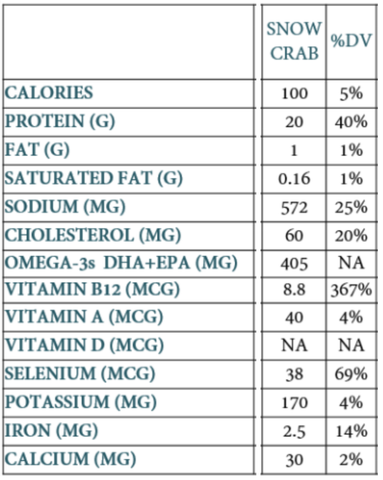All About Our Bairdi Crab

Product Info
- Caught: February
- Location: SE Alaska
- Method: Pots
- Clusters vacuum-packed & flash frozen (brine frozen and water glazed)
- Cooked to perfection
- 3kz (~6.6lb) bags in box dimensions 13”x 20” x 3¾”
- Generally holds over 18 months
All About “Snow Bairdi” Crab
Chionoecetes bairdi (Tanner) and Chionoecetes opilio (Snow) are two species of crab so close in proximity and relation that they often crossbreed, producing regions with high numbers of hybrids. Both species are commonly referred to as Tanners, and both species take to the market as Snow Crab--they are only differentiated by discrete details and the use of their species name, “bairdi” or “opilio”). Chionoecetes translates to “snow inhabitant,” for the Tanner are found in the Bering Sea along the continental shelf and coastal waters and throughout the North Pacific Ocean. Unlike some decapods that claim the “crab” name for association, Tanners are “true crabs,” with four pairs of legs, one pair of pincer claws, and a chitinous shell with a small abdominal flap. Tanners are some of the most highly specialized crustaceans.
Today, the commercial catch is restricted to mature males (usually 7 to 11 years of age), which typically weigh one to four pounds after six years. Bottomfish share the appetite for Tanner crabs’ white meat.
Tanner sexes remain separated for much of the year and merge together during reproductive seasons. The male crab is attracted to the female by a chemical pheromone, released during her maturity molt (the last shedding of the outer shell in development). Hatching begins as early as late winter to early spring, with the peak period usually taking off in April to June when the spring plankton bloom provides an abundance of food for larvae crab as they swim about. After 60 days, the larvae lose their swimming ability and settle to the ocean bottom. Numerous molts and five to six years of growth develop a mature Tanner crab that may live up to fourteen years.
Most Tanners are harvested from the Bering Sea Fishery, which opened in 1961 and became of great significance in the North Pacific with record catches as high as 332 million pounds. Japan and Soviet Russia were responsible for a great portion of the catch until 1976, when the Magnuson Fishery Conservation and Management Act established the 200 mile Economic Exclusion Zone, claiming the fishery for the US. By 1984, the harvest was down to just over one million pounds. Legislators and fishery management shut down harvesting entirely in 1986 and 1987 in an attempt to reverse the damage done from overfishing. The fishery reopened in 1988 with restrictions but closed again within the decade due to a dwindling harvest in 1996. The stocks recovered for reopening by 2004. That year, Alaskan fishery managers introduced the "Crab Rationalization Program," modeled after pre-existing programs in New Zealand and the North Atlantic. The program introduced individual fishing quotas based on each vessel's previous catches and retaining a percentage to be marketed in regions where they were caught. The CPR applies to the small fishery in Southeast Alaska, where Alaska Select sources its Snow Bairdi Crab.
According to Alaska Department of Fish and Game (ADFG), Alaska’s tanner crab populations are now managed for maximum sustainable yield, and as such, fluctuate within the realm of stability. Today crabs are fished by a diversity of vessels ranging from small inshore sustenance boats to commercial "super crabbers" in the Bering Sea (as you may have seen on “Deadliest Catch”). Fishing gear consists of crab pots baited with fish such as chopped herring.
Alaska Select’s Snow Bairdi Crab
According to the Alaska Department of Fish and Game (ADFG), tanner crabs support a small and stable fishery in Southeast Alaska, where Alaska Select sources its fish:
“The directed pot fishery began in the 1960s, (and) has gone from year-round in the 1960s and 1970s to only a few days in recent years. In addition to size and sex limits, the fishery has been regulated by limited entry for pot gear, a vessel pot limit, and a guideline harvest level.”
Alaska Select sources pot-caught Snow Bairdi Crab from a small, local, family operation that fishes over two weeks in February.
Nutritional Value of Snow Bairdi Crab
Snow Bairdi Crab is high in Omega 3s, amino acids, iron, niacin, selenium, potassium, and vitamins A, B12, C, and D.
- Omega-3 fatty acids provide cardiovascular benefits such as preventing erratic heart rhythms, aiding blood flow inside arteries where clots can cause heart attacks, and balancing the ratio of good High Density Lipoprotein (also preventing atherosclerosis). Omega-3s reduce triglycerides, a potentially harmful fat in our bloodstream. Omega-3s also reduce inflammation, which is a key component in the processes that turns cholesterol into artery-clogging plaques.
- Amino acids are the building blocks of protein, needed for the development of tissues in the body, including muscles. They are the precursors to hormones, immune response, repair, and other molecular essentials for health.
- Iron is an essential mineral for the protein hemoglobin to transport oxygen throughout the bloodstream.
- Niacin (Vitamin B-3) is essential to the entire body’s functioning. Niacin can help lower cholesterol, ease and even prevent arthritis, and boost brain function.
- Selenium acts as a powerful antioxidant, supporting liver function, in turn detoxifying and clearing potentially harmful compounds such as pesticides, drugs, and heavy metals from the body. Selenium reduces risk of chronic diseases like heart disease, Alzheimer’s disease and cancer, combating premature aging and risk of stroke.
- Potassium is a necessary mineral for muscle movement, a healthy nervous system, and balanced water retention in the body.
- Vitamin A is the umbrella term for several fat-soluble compounds. These compounds are vital to many processes in the body, such as the maintenance of healthy vision, immune system functions, organ upkeep, and growth and development during pregnancy.
- Vitamin B12 helps lower levels of homocysteine, reducing damage to artery walls.
- Vitamin C is an essential nutrient (needed, yet not produced within the body) involved in the repair of tissue, enzymatic production, and immune system functions. It also serves as an antioxidant, fighting negative effects of free radicals.
- Vitamin D is essential in regulating the absorption of calcium and phosphorus, facilitating normal immune system functions and the healthy development of bones and teeth. Vitamin D helps with weight-loss and depression prevention.
Up-to-date nutritional value of Alaskan Snow Bairdi Crab (2019), based on a 3 oz (⅔ cup, or 85g) serving serving size:

Culinary Profile of Snow Bairdi Crab
Snow Crab is reputed for its sweet flavor, “snowy” white meat, and fibrous texture. Of the “Snow Crabs” (Bairdi and Opillio), Bairdi trends as the more premium, and even “best crab available on the market,” by crab lovers and the culinary world. Alaska Select sells Snow Bairdi Crab brine frozen and water glazed, “cooked to perfection” for convenience. It is best enjoyed cold-- thawed out in the refrigerator overnight or in a room-temperature bath hours before. If desired served hot, the crab needs to be slowly warmed to avoid overcooking (or losing moisture).
Snow crab is considered a delicacy as such that it is most commonly celebrated as a meal centerpiece, with simple combinations of butter, garlic, lemon, and/or light spices.
